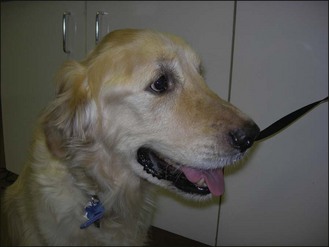66 Bilateral atrophy of the masticatory muscles
CLINICAL EXAMINATION
Clinical examination revealed a mentally depressed dog with petechia of the conjunctiva and retina bilaterally. Mucous membranes were pale. The temperature was 39.7°C. There was a generalized muscle loss, including masticatory muscles bilaterally (Fig. 66.1). Jaw tone was good. The dog had normal facial muscle function. Sensation to the face was present. No neurological deficits were found.
Stay updated, free articles. Join our Telegram channel

Full access? Get Clinical Tree



